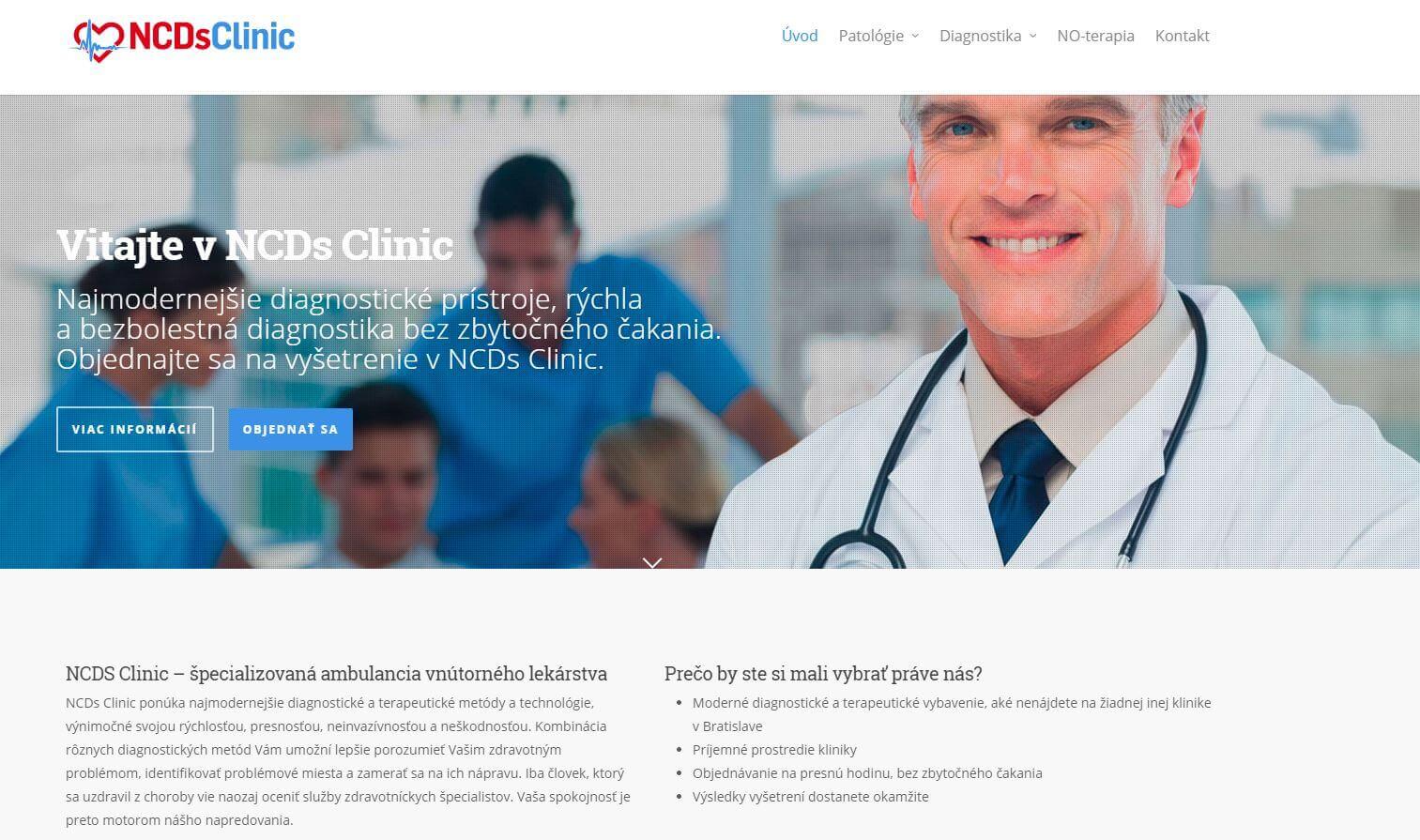Medical devices
search
news
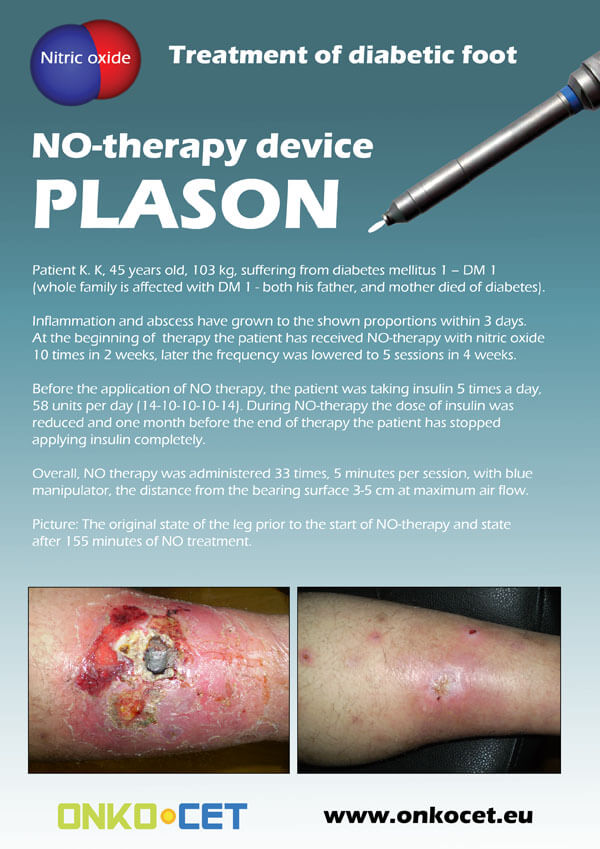
The PDF with the short report with pictures from the therapy of a diabetic foot can be viewed or downloaded here.
The pictures from the treatment of unhealing wounds an be found here:
http://www.onkocet.eu/en/produkty-detail/220/1/
The pictures from the treatment of unhealing wounds an be found here:
http://www.onkocet.eu/en/produkty-detail/293/1/
ONKOCET Ltd. has exhibited the devices from its portfolio on the MEDTEC UK exhibition in Birmingham, April 2011 through our partner Medical & Partners.
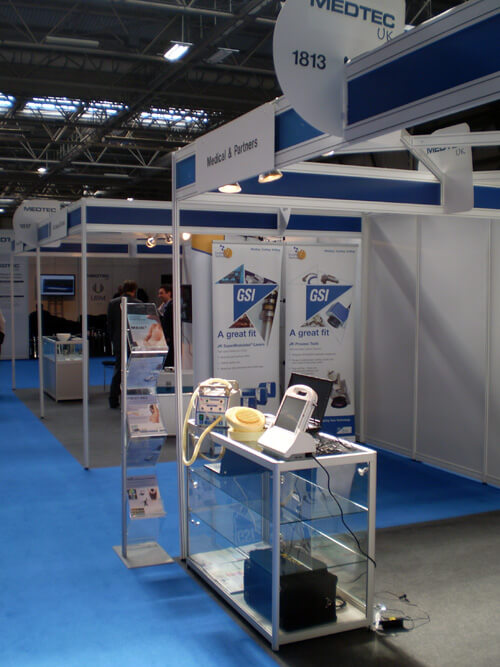
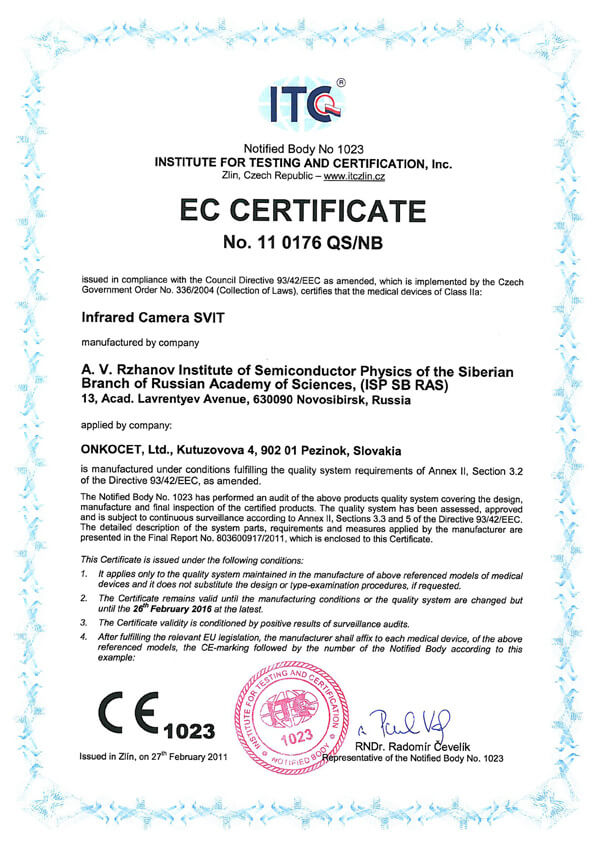 The ONKOCET company has successfully reached the certification of yet another medical device, Infrared Camera SVIT. The Certificate can be found here. The videos from the device operation can be found here.
The ONKOCET company has successfully reached the certification of yet another medical device, Infrared Camera SVIT. The Certificate can be found here. The videos from the device operation can be found here.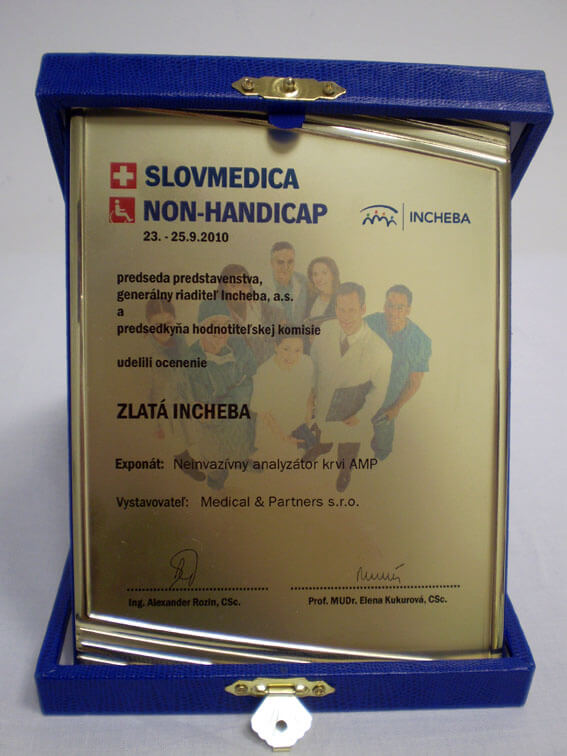 Our device, the non-invasive blood analyzer AMP has won the Golden Incheba prize at a medical exhibition SLOVMEDICA - NON-HANDICAP 2010. A big thank you goes to the organizers of the exhibition for acknowledging the quality of our device and to the exhibitor, the Medical & Partners company, for introduction of the AMP device to the medical public again.
Our device, the non-invasive blood analyzer AMP has won the Golden Incheba prize at a medical exhibition SLOVMEDICA - NON-HANDICAP 2010. A big thank you goes to the organizers of the exhibition for acknowledging the quality of our device and to the exhibitor, the Medical & Partners company, for introduction of the AMP device to the medical public again.We are pleased to inform our business partners, that our company has succesfully finished the certification process of Concor Soft Contact Lenses.
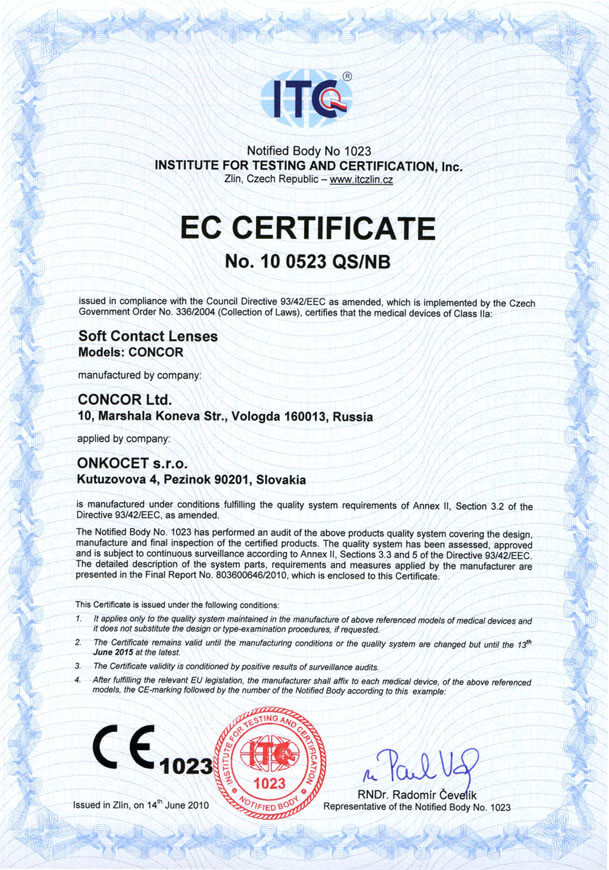 You can find the certificate here.
You can find the certificate here.More information on Concor Soft Contact Lenses go to section Medical preparations/Concor soft contact lenses, or follow this link.
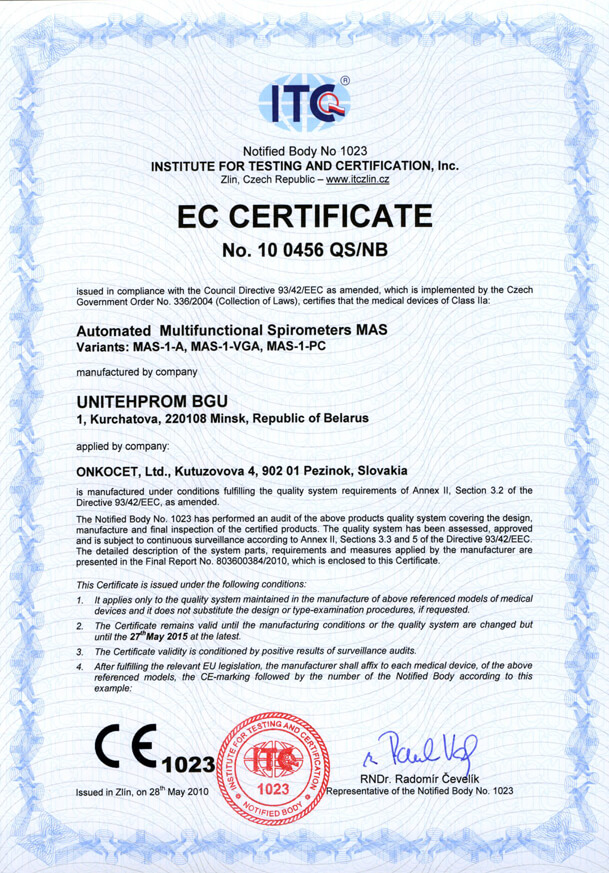 Our company has finished the certification process for another medical device, computerized spirometer MAS-1K with oximeter. You can find the device certificate here.
Our company has finished the certification process for another medical device, computerized spirometer MAS-1K with oximeter. You can find the device certificate here..jpg) Since May 2010 there is a new version of AMP device available.
Since May 2010 there is a new version of AMP device available.Follow this link if you want to see the pictures and specifications of the device.
http://www.onkocet.eu/en/produkty-detail/293/1/
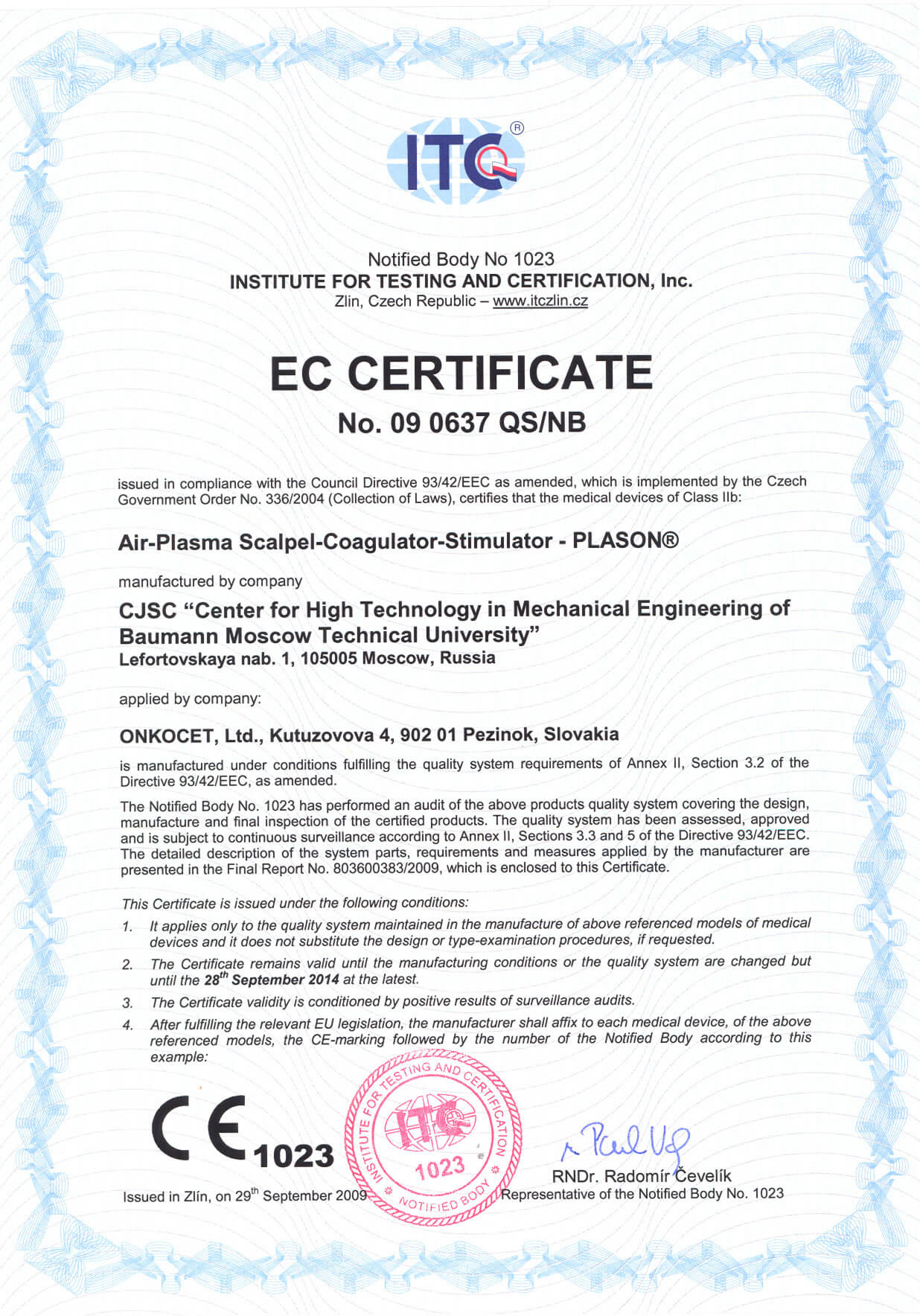 Dear partners,
Dear partners, In October 2009 we have received CE certificate for another device from our portfolio, NO therapeutical device PLASON. You can find more information about this revolutionary device, used for healing of unhealing wounds, diabetic foot, or for cosmetical purposes, at our webpage, section "Medical devices" -> PLASON-NO Therapy.
.gif)
Best regards
Team of ONKOCET Ltd. company
Experimental study of action exogenous NO on the wound process
Experimental study of action exogenous NO on the wound process
A study carried out in Sechenov Moscow Medical Academy on 170 white rats included several sets of experiments on the models:
1) conditionally aseptic fully layered planar wound with area 300 mm2,
2) the same infected with Staphylococcus aureus of purulent wound area and
3) linear skin wound with the length of 3 cm.
To 2, 3 and 4 days in the experimental groups of the I and II series the wound surface also of the edge of wound finished during 60 sec, and in the III series - during 15, 30 and 60 sec by the NO- containing gas flow (NO -CGF), generated by apparatus “PLASON” (concentration NO - 500 ppm). In the control of wound they blew out by air at the same temperature. To 4, 7, 10, 14 and 21th days on 2-3 animals derived from the experience, selected biomatherial of the cloths of the wounds, which were studied by histological and histochemical methods, using paintings with hematoxylin and with eosin, Van- Gieson`s picrofuchsin, by toluidine blue to proteoglycan, Gomori`s silver, PAS- reaction to glycogen and glycoproteins, Brashe`s reaction to RNA and by Feulgen`s on DNA, and electron-microscopic examination also was conducted. Remaining rats left to the complete healing of wounds, planimetry of wounds was carried out every 3 days in them, data were processed statistically
IN the I set of experiments for the development the influences of NOx- therapy for the preventive maintenance of the wound complications of the rule of asepsis intentionally were not observed. In the control group in 42% of animals to 3 and 5 days appeared the signs of purulent inflammation. In the experimental groups these complications were absent. A planimetric study showed that in the experimental groups the area of wounds was decreased considerably more rapid than in the control (Fig. 1A). The average period of the complete healing of wounds in the test decreased for 7,5 days, the index of the acceleration of healing composed 24,6%.
Histological, histochemical and electron-microscopic examinations showed that from 4 days in the experience is noted the significant acceleration of the wound process, which to this period, in contrast to the control, already passes from the inflammatory to the reparative phase. In the bottom of wound is well developed granulating cloth (in the control - only centers in inflammatory- infiltrated cellulose tissue), are expressed the proliferation of the fibroblasts (many mitoses), the new formation of capillaries, fibrillogenese of collagen, the accumulation of proteoglycans and PAS- positive glycoproteines (Fig. 2). Fibroblasts are characterized by the increased content RNA in the cytoplasm, and it is ultrastructural - by signs of the increased synthesis of protein, by well developed granular endoplasmic reticulum and by Golgi` complex (Fig. 3). Considerably more strongly is expressed in the experience macrophage reaction, including the phagocytic activity of macrophages. This is manifested in the increased content of phagosomas and lysosome in their cytoplasm. The phagocytosis of microbes by macrophages and by neutrophils is intensified, the colonies of bacteria on superficial wound are revealed only in control animals.
Especially should be noted differences in the microcirculatory reaction. In the experience the vasodilation of the newly formed capillaries is revealed; however, such phenomena as the destruction of endothelium, agglutination of erythrocytes, aggregation of thrombocytes, micro-thrombosis, adhesion and increased migration of neutrophils are expressed considerably weaker than in the control, and in the succeeding periods they disappear. Granulating cloth rapidly ripens in 7 - 10 days in the experience, while in 14 days it undergoes fibrocicatricial transformation, the reduction of capillaries and fibroblasts occurs, the large fields of collagenic fibrils appear, increases boundary epithelisation and differentiation of the epithelium (Fig. 4). To 21 days in the experience, in contrast to the control, the epithelization in the majority of animals concludes, begins remodulation of scar tissue, inflammatory manifestations are absent.
IN the II set of experiments, where the wounds were infected with staphylococcus, their area in the experience also was decreased more rapidly than in the control (Fig. 1B). The average period of the complete healing of wounds was accelerated by 31,6%. Morphological study in the control group to the 4th day revealed the sharply pronounced and prolong signs of microcirculatory disturbances, neutrophilic infiltration, edema, vasculita, the formation of primary and second necroses, micro-abscess, the significant infection of wounds, braking the phagocytosis of microbes and necrotic detritus, inhibition of macrophage reaction, proliferation of fibroblasts, increase in the capillaries, ripening of granulating cloth and epithelisation. In the experience all these signs were expressed considerably more weakly and more rapidly they disappeared. Granulating cloth was developed from the 4th day, and from the 14th day, in contrast to the control, its fibrosis formation occurred, contraction began epithelisation.
IN the III series in 2 groups of experiences NO, obtained by plasma-chemical (apparatus “PLASON”) or chemically (gas mixture NO and N2), with the identical concentration it was used for the action on the linear wounds, which simulated, bringing in the inter-blade region of animal the linear section with a length of 3 cm and with depth of up to its own fascia. The obtained wound they took in 3rd by knotty catgut seams. In the control group analogous wounds processed in no way. To the 7th day the animals euthanised and was removed from the back the rag of the skin, which contains the scar of the healed to live linear wound. Perpendicular to the line of scar from the sections between the seams the strip of cloth with a width of 3-4 mm and with a length of 2-2,5 cm (scar it was arranged in the center of strip) was cut out. Were conducted the biomechanic tests of the obtained models in the tensile testing machine “Instron”. Tensiometry showed a noticeable increase in the strength of scar (2,5 - 2,7 times) in comparison with the control, which indicates strengthening of the synthesis of collagen. In this case there was a dose dependence - maximum effect was revealed with the exposure 30 it flogged (Fig. 5). Morphologically in the experimental groups wedge-shaped scar was considerably already, it consisted of riper mature (rich in collagenic fibers) connective tissue, superficial wound in all animals (in contrast to the control) was covered with epidermis (Fig. 6 and 7). In practice identical results, obtained with the use of an apparatus “PLASON” and the gas mixture of nitrogen and NO, attest to the fact that precisely NO answers for the bio-stimulation action of the cooled air- plasma flow.
In the same series were executed the 3 additional groups of experiments on the development of antibacterial effect of NO: in the 1st group linear wounds were conditionally aseptic, and in the 2nd and the 3rd - they were infected with Staphylococcus aureus. In 1 and 2 groups of wound left without the treatment, while in 3- was carried out NOx- therapy. Observations showed that in 1 group in 41,7% of cases, and in it was 2nd in 100% it was developed festering and wounds healed by second intention. In 3 groups only in third of animals (33,3%) the infected with Staphylococcus aureus wounds festered; moreover the manifestations of suppuration were less expressed than in 1 and 2 groups. In the remaining cases of 3 groups of wound they healed by first intention, which indicates antibacterial influence of NO -CGF.
Thus, experimental studies showed that exogenous NO, generated by plasma-chemical method from atmospheric air, normalizes microcirculation, renders antibacterial action, dilutes infection and inflammation, it prevents festering, it activates the function of macrophages and the proliferation of fibroblasts, stimulates the regeneration of cloths, considerably accelerates the healing of the fully layered planar and linear wounds, including of those infected.
